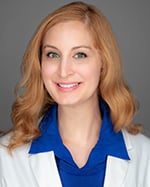ESPN’s Hannah Storm Shares Breast Cancer Diagnosis
Sports journalist Hannah Storm shared recently that she was diagnosed with non-invasive, stage zero ductal carcinoma in situ (DCIS), a breast cancer where cells that line the milk ducts of the breast become cancerous.
She told People Magazine that doctors discovered an area of concern after a mammogram last fall and recommended an ultrasound and a biopsy.
“I just heard ‘breast cancer’ and I was shocked,” Storm told the magazine. “I was so stunned. I've had yearly mammograms and there was never anything, I have no family history. I had no pain. I had no lumps. I literally had nothing that would've indicated that I had breast cancer.”
The type of cancer Storm had, DCIS, is a noninvasive form of breast cancer, according to Dr. Dana Ataya, a breast radiologist at Moffitt Cancer Center. She adds that up to 25% of DCIS lesions will be upgraded to an invasive cancer at the time of surgery while other DCIS lesions may never progress to that stage.

“Most women who get diagnosed with breast cancer have no family history of breast cancer,” Ataya said. “That’s why a yearly screening mammogram beginning at age 40 is so important for all women.”
Storm had a lumpectomy, where a surgeon removes only a portion of the breast tissue and allows for a faster recovery than a more extensive surgery. She told the magazine she now takes an estrogen modulator that helps prevent the development of hormone receptive-positive breast cancers for the next three years.
Storm said she felt “extremely lucky” that her cancer was detected at the earliest stage and was able to return to work rather quickly.
As with most cancers, not all DCIS lesions are the same, Ataya said, and personalized care is an important part of treatment.
Getting screened annually is a crucial step women can take to remain healthy and catch signs of breast cancer at their earliest stage.
“Both the American College of Radiology and Society of Breast Imaging encourage women to maximize the lifesaving benefits of mammography by continuing annual screening if the patient is in reasonably good health and expected to live at least five to 10 more years,” said Dr. Kimberly Funaro, a breast radiologist at Moffitt.
Both the ACR and SBI recommend a yearly mammogram beginning at age 40 for average risk women, and to continue screening as long as a woman is in good health. For women at a higher risk for developing breast cancer, screening should begin earlier and be more enhanced.
“Hannah Storm’s personal story is important because it emphasizes the importance of screening mammography in catching breast cancer early when it is easier to treat,” Ataya said.



